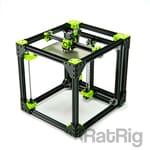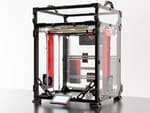In the 3D printing world, there are two categories of people: the tinkerers and the “plug-and-play” ones. While the second group prefers a machine ready out of the box, the first group likes building and modifying their printers, creating a custom machine. DIY projects are loved by tinkerers, and this list is perfect for them and for those who would like to enter this world.
In this article, we’ll talk about the best DIY CoreXY 3D printers out there. While DIY is a more famous acronym that stands for “Do It Yourself”, CoreXY may need a little introduction. Lots of different motion systems exist in the 3D printing world. The most common one is the Cartesian style, as it’s used in the vast majority of the 3D printers on the market.
The most common types of Cartesian printers are rectilinear: square or box-like printers that employ linear movements. Many of these printers separate the movements of the X- and Y-axes, but CoreXY 3D printers use two motors that control both of the axes together. Below, we’ll see the advantages of such printers, but first, let’s address some important considerations to keep in mind when selecting a DIY CoreXY printer.
Considerations

There are hundreds of DIY CoreXY designs out there. Since we’re talking about the best ones, we had to establish some criteria to choose the best from the rest. In particular, we considered the following:
- Support materials: Guides and tutorials are absolutely necessary when you’re talking about DIY machines. Assembling a CoreXY system is one of the most difficult parts of the build. Another important aspect is the wiring. Connecting the cables in the wrong way to the motherboard can fry all of your components or worse your house, so wiring guidance is essential.
- Community: Another important factor to consider when you choose a DIY 3D printer is the size of its user community. The community has two main functions: helping you resolve problems while building the printer and encouraging you to customize it, making it exactly how you like.
- Customizability: Most likely, you choose to build a DIY printer because you want to be able to build a machine that suits your needs and reflects your taste. The available modifications out there and the possibility of customization are crucial considerations when choosing a project.
- Price: Everyone has a budget. Obviously, you can improve your machine over time, but we have to take into account the initial cost to have a complete overview.
Now that we know what a DIY CoreXY machine is and what to consider when choosing one, let’s dive into the list!
Voron

Voron is arguably the most famous project in the DIY 3D printer world. Born in 2015, Voron has gone a long way from its origin, now offering five models, of which three are CoreXY machines. Although each model uses a CoreXY system, they all have different build volumes and Z motion systems.
The smallest of the collection is the Voron 0.2, with a built volume of 120 mm³. Its two major sisters are the Voron 2.4 R2 and the Voron Trident. Check out our article comparing both models to find out more about their differences.
The guides for the Voron Project are plenty, and the community is the biggest one out there. You can either buy a kit or you can go down the self-sourced path. The latter was the most common option some years ago, but now, there are many high quality kits out there from various retailers. If you decide to build one, you should definitely check out their Discord group!
- Price: From $380 for V0.2, $570 for Trident, and $750 for 2.4 R2, all depending on the retailer
- Build volume: 120 x 120 x 120 mm for the V0; from ~250 x 250 x 250 mm to ~350 x 350 x 350 mm for the 2.4 and the Trident
- Source files: Voron Design
Rat Rig V-Core 3.1

Another really famous machine is the Rat Rig V-Core 3. This Portuguese company has created a fantastic 3D printer that you can buy in either a standard kit or a customized one. One of the main advantages of the Rat Rig over the other projects is the dimensions. Your Rat Rig can arrive at 400 mm³ or even 500 mm³ of build volume, perfect for those who need a big printer for big projects.
RatRig offers makers an entire site with the instructions for the assembly and firmware configuration. You can even choose between the classic Klipper or a customized version, the RatOS, which makes the firmware side even easier. If you decide to build one, join their Facebook group for additional help.
- Price: Starting at $1,200
- Build volume: From 200 x 200 x 200 mm to 500 x 500 x 500 mm
- Source files: Rat Rig Docs
VzBoT

Working at 50k mm/s² of acceleration, the VzBoT is one the fastest 3D printers in the world. Born from a modified Tronxy, the VzBoT is now a complete project with a completely customized extruder and hot end, the impressive Goliath. There are even kits available.
Many guides for building this machine can be found on the site, and the creator has also uploaded some videos to help you with the build. Every version of their machines has its own page – printed vs. kit, 235 vs. 330 – making it really simple to follow the instructions. There’s also a Discord channel, which has over 8,000 users who will be happy to help you build your VzBoT.
- Price: ~$1,250 for VzBoT 235; ~$1,330 for VzBoT 330
- Build volume: 235 x 235 x 205 mm; 330 x 330 x 400 mm
- Source files: VzBoT
ZeroG

Another DIY CoreXY project is ZeroG. Inspired by Voron, ZeroG is a design team that aims to transform your Ender 5 – or similar models, such as the Sovol SV05 – from a stock machine to an absolute beast of custom 3D printers. It proposes the Mercury One.1, a system to convert your Cartesian XY-head setup into a beautiful CoreXY motion system. You can even go a step further and completely transform your printer with the Hydra system.
This project is increasingly gaining popularity, and the community is expanding. There’s even a Discord channel of a few hundred people. On their site, you’ll find a lot of support material, but pay attention that this project is younger than the majority of the other ones on this list. For that reason, the written guide can lack some steps.
You should definitely check YouTube for builds by other makers if you choose this option. Fortunately, a Fabreeko kit has recently been released to help you with the hardware side.
Rook

The Rook is a project designed by Rolohaun Design with the objective of creating an almost entirely 3D printed machine that’s cheap and can be built by anyone. The printer is becoming more and more well-known thanks to the SpeedBoatRace, in which it’s gaining a pretty good place in the ranking.
As the designer says, the Rook is a beginner-friendly machine that can be built to learn more about this technology and its firmware, Klipper. In fact, this is the easiest printer to build on the list, so if you’re a newbie, you should definitely consider the Rook.
The creator is also publishing the complete tutorial of the assembly, and a HoneyBadger kit has recently been released to help you with the hardware components that can’t be printed.
- Price: ~$300
- Build volume: 120 x 120 x 120 mm; 150 x 150 x 150mm
- Source files: Printables, GitHub
- Retailers: Fabreeko
License: The text of "DIY CoreXY 3D Printer: The Most Exciting Designs" by All3DP is licensed under a Creative Commons Attribution 4.0 International License.
CERTAIN CONTENT THAT APPEARS ON THIS SITE COMES FROM AMAZON. THIS CONTENT IS PROVIDED ‘AS IS’ AND IS SUBJECT TO CHANGE OR REMOVAL AT ANY TIME.



